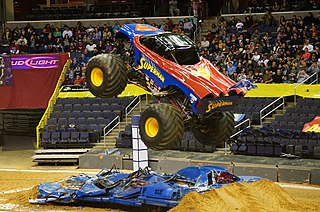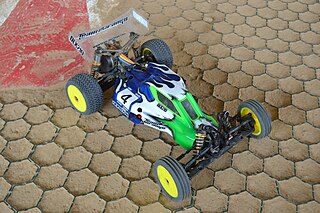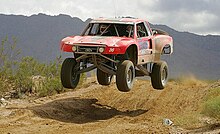
A mountain bike (MTB) or mountain bicycle is a bicycle designed for off-road cycling. Mountain bikes share some similarities with other bicycles, but incorporate features designed to enhance durability and performance in rough terrain, which makes them heavier, more complex and less efficient on smooth surfaces. These typically include a suspension fork, large knobby tires, more durable wheels, more powerful brakes, straight, extra wide handlebars to improve balance and comfort over rough terrain, and wide-ratio gearing optimised for topography, application and a frame with a suspension mechanism for the rear wheel. Rear suspension is ubiquitous in heavier-duty bikes and now common even in lighter bikes. Dropper posts can be installed to allow the rider to quickly adjust the seat height.

Suspension is the system of tires, tire air, springs, shock absorbers and linkages that connects a vehicle to its wheels and allows relative motion between the two. Suspension systems must support both road holding/handling and ride quality, which are at odds with each other. The tuning of suspensions involves finding the right compromise. It is important for the suspension to keep the road wheel in contact with the road surface as much as possible, because all the road or ground forces acting on the vehicle do so through the contact patches of the tires. The suspension also protects the vehicle itself and any cargo or luggage from damage and wear. The design of front and rear suspension of a car may be different.

The Mitsubishi Lancer Evolution, popularly referred to as the 'Evo', is a sports sedan and rally car based on the Lancer that was manufactured by Japanese manufacturer Mitsubishi Motors from 1992 until 2016. There have been ten official versions to date, and the designation of each model is most commonly a Roman numeral. All generations use two-litre intercooled turbo inline four-cylinder engines and all-wheel drive systems.

A monster truck is a specialized off-road vehicle with a heavy duty suspension, four-wheel steering, large-displacement V8 engines and oversized tires constructed for competition and entertainment uses. Originally created by modifying stock pickup trucks and sport utility vehicles (SUVs), they have evolved into purpose-built vehicles with tube-frame chassis and fiberglass bodies rather than metal. A competition monster truck is typically 12 feet (3.7 m) tall, and equipped with 66-inch (1.7 m) off-road tires.

A truggy is a type of high performance off-road racing vehicle that combines features from two older existing categories of off-road racing vehicles, trucks and buggies. The first truggies were built for racing in the SCORE and BITD off-road desert racing series, held in Mexico, California, Nevada and Arizona.

Off-roading is the act of driving or riding in a vehicle on unpaved surfaces such as sand, dirt, gravel, riverbeds, mud, snow, rocks, or other natural terrain. Off-roading ranges from casual drives with regular vehicles to competitive events with customized vehicles and skilled drivers.

The Toyota Tacoma is a pickup truck manufactured by Japanese automobile manufacturer Toyota since 1995. The first-generation Tacoma was classified as a compact pickup. The second generation and third generation models are classified as mid-sized pickups. The Tacoma was Motor Trend's Truck of the Year for 2005.

The Dodge Power Wagon is a four-wheel drive medium duty truck that was produced in various model series from 1945 to 1980 by Dodge. The Power Wagon name was revived for the 2005 model year as a four-wheel drive version of the Dodge Ram 2500. As a nameplate, "Power Wagon" continues as a special package of the four-wheel drive version of 3/4 ton Ram Trucks 2500 model.

The Mitsubishi Pajero is a full-size SUV manufactured and marketed globally by Mitsubishi over four generations — introduced in 1981 and discontinued in 2021.

The SJ series Jeep Cherokee is a full-size SUV that was produced from 1974 through 1983 by Jeep. It was based on the Wagoneer that was originally designed by Brooks Stevens in 1963.
Kyosho Corporation is a Japanese company based in Tokyo, which operates internationally under the name KYOSHO. The company's main office is located in Chiyoda, and the production headquarters are located in Atsugi, Kanagawa.
A motorcycle's suspension serves a dual purpose: contributing to the vehicle's handling and braking, and providing safety and comfort by keeping the vehicle's passengers comfortably isolated from road noise, bumps and vibrations.
Sylva Autokits is a kit car manufacturer based in Lincolnshire, England. Sylva was founded in 1981 by Jeremy Phillips and has developed and produced a number of small and lightweight sports cars. Sylva cars have won a number of 750 Motor Club Kit Car championships.
SCOREClass 2 is an unlimited four wheel single & two-seat vehicle class. The maximum engine size is a 3.5 liter, six cylinder forced air induction engine. Engines must have no more than six cylinders but forced induction is open to both turbo and superchargers. The minimum weight is 2,000 pounds.
SCOREClass 1/2-1600 is an Open Wheel restricted suspension, limited Volkswagen motor class that competes in the SCORE off-road race series including the Baja 1000, Baja 500, Baja Sur 500, San Felipe 250 and the SCORE Desert Challenge. No production bodied vehicles are allowed in this class.
Jeepspeed is an off-road organization and class of racing vehicle. The Jeepspeed organization was founded by Mike Barnett and Clive Skilton in 2001 after Clive's visit to the Dakar Rally in Africa with his son and multi-time Dakar Rally competitor, Darren Skilton, with the intent to build a racing vehicle and series around the affordable and durable Jeep. Jeepspeed developed relationships with race promoters like MORE and Best in the Desert to create a five to seven race Jeepspeed racing series each season. The class has since expanded into four divisions and opened up to other Jeep and Dodge vehicles.

Robert Pierce was an American off-road racer, owner of Jimco Racing, and former owner of MasterCraft Safety and Impact Products. Pierce raced a Jimco Trophy Truck in the SCORE International desert racing series and previously raced a Pro2 Unlimited truck in the Lucas Oil Off Road Racing Series (LOORRS).

A 1:10 radio-controlled off-road buggy is a 1:10 scale radio-controlled dune buggy designed for off-road racing. These cars are based on their full-scale equivalents that are commonly found in desert racing. The buggies are split into two race categories, two (2WD) and four-wheel drive (4WD). These can easily be distinguished visually by their wheel size at the front. Cars are typically electric powered, but nitro versions do exist but are less common because racing classes exist for electric cars. The class is inexpensive and similar to a number of other classes, and this makes them popular with newcomers. The cars are also known as 1/10 off-road.

The Raptor is a nameplate used by Ford for its "high-performance" pickup trucks and SUVs. In use since the 2010 model year, the Raptor is designated as the highest-performance version of the F-150, Ranger and Bronco. Drawing its name from both bird of prey and the velociraptor, the model line is intended as a street-legal counterpart of an off-road racing trophy truck. The F-150 Raptor is currently in its third generation; the Ranger Raptor was introduced in 2019 while the Bronco Raptor was released in late 2021.
The SuperUtes Series is an Australian pickup truck racing competition that was launched in 2018 as a successor to the V8 Ute Racing Series. The series' events are held as a support category to Supercars Championship events throughout Australia.














